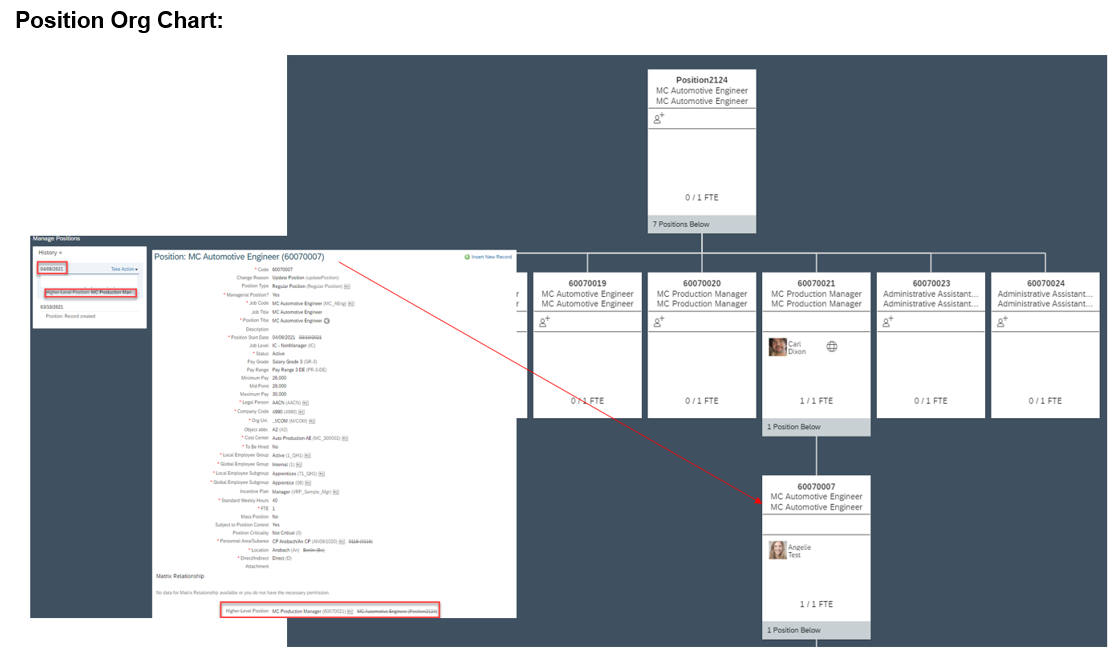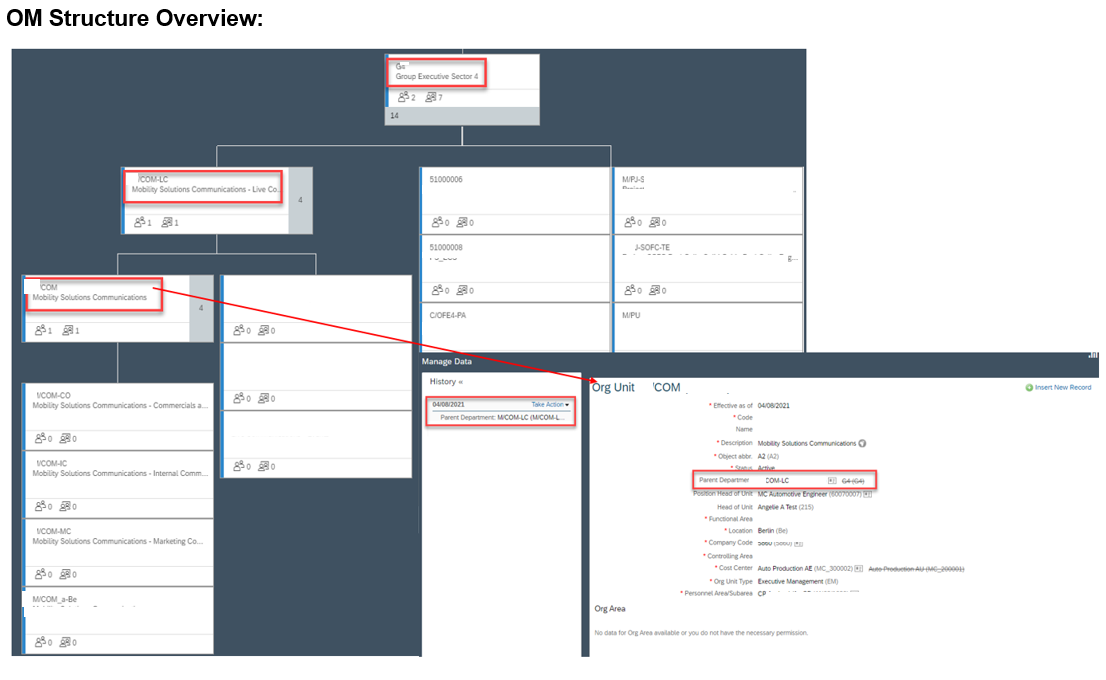
- SAP Community
- Products and Technology
- Human Capital Management
- HCM Blogs by SAP
- On Premise Customers requirements to have EC OM in...
Human Capital Management Blogs by SAP
Get insider info on HCM solutions for core HR and payroll, time and attendance, talent management, employee experience management, and more in this SAP blog.
Turn on suggestions
Auto-suggest helps you quickly narrow down your search results by suggesting possible matches as you type.
Showing results for
Product and Topic Expert
Options
- Subscribe to RSS Feed
- Mark as New
- Mark as Read
- Bookmark
- Subscribe
- Printer Friendly Page
- Report Inappropriate Content
05-12-2021
1:08 PM
INTRODUCTION
Normally, onprem customer requires to have SuccessFactors Employee Central Organization Hierarchy in Sync with Position Hierarchy. This is because their HR process are defined based on the OM hierarchy and also because this hierarchy needs to feed the consumer systems. With the implementation of SuccessFactors Employee Central, the adopted leading hierarchy is the Position, making the OM hierarchy dependent on it.
As know, the successFactors Employee Central is based on the Position as a leader hierarchy and there is currently no standard automation/synchronization between Position and OM.
SOLUTION
Option 1: Manual OM update
A manual update is recommended from SAP where there will be a need to have a scheduled report that drives the OM responsible for checking if there is any difference between Position and OM hierarchy that needs to be adjusted and after this, a massive CVS file can be imported.
Option 2: Custom solution (Details below)
Requirement #1: Change of Cost Center
Detail: Customer requires to have an automatic update of the correspondent Org Unit when its Head of Position Cost Center is changed.
Solution: Intelligent Services Center (ISC) + Integration Center (IC)
An Intelligent Service Flow is created under the Event ‘Update/create Position’ to triggers the attribute update.
In the ISC a new flow with the IC ‘Pos to OM Attribute Sync (ISC) is assigned, without any specific rule, which means that it will be triggered every time that there is a position change (Image below):

Image 1 from Demo
The IC template is filtering only the ‘Managerial Positions’ which means that any other will never be taken into account for this update (Image below):

Image 2 from Demo
The template is using the ‘Position’ as the main entity – where we will look for the data to be updated in the Org Unit and as a destination it is using the entity ‘Department’ (customer's Org Unit).
The update mapping will consider the Position Cost Center to the Org Unit Cost Center, so in case there is a change, the Position Cost Center will be updated into the Org Unit Cost Center which this position is the head.

Imagine 3 from Demo
Once the Managerial Position Cost Center is changed, it will automatic triggers the ISC event which will create the IC file and update the Org Unit with the same date as the Position change. Below example of how the change will look in each object:

Image 4 from Demo
Requirement #2: New Managerial Position not in line with OM structure
Detail: Customer requires to not allow a managerial position to be created not inline with the Parent Position Org Unit. Example: Org Unit A has the position 123 as the head. Org Unit B is created and a new managerial child position 567 is created under the 123, but once selecting the Org Unit you pick the Org Unit C, instead of B, the system should not allow you, since it is not following what was defined/created in terms of hierarchy for the Org Unit A and its position head.
Solution: A Business Rule can be created to prevent this incorrect assignment by triggering an error message. Additional to that, a custom table is daily updated with Position data, in order to allow the rule to check for the parent position information.
At the Position Object Level, the Business rule is assigned as onChange at the Org Unit Field (standard Department) level.

Image 5 from Demo
LOGIC
Is a managerial Position = true
Position Higher Level Position = true
Higher Level Position Org Unit is the Parent of the selected Org Unit = false
RESULT
Trigger a error message = ‘OM_POSSyncMessage’(below example from the system).

Image 6 from Demo
Requirement #3: Higher Level Position sync to Org Unit hierarchy
Detail: Customer requires to have an automatic update in the OM structure when a managerial position has its position head changed.
Example: Currently the Position Head C has the Position Head A as its parent (following OM structure). In case I change the parent from Position Head A to Position Head B, the OM structure must be changed to be in sync with the Position Hierarchy (below image).

Illustrated Image
Solution: Intelligent Services Center (ISC) + Integration Center (IC)
An Intelligent Service Flow is created under the Event ‘Update Position’ to triggers the attribute update.
In the ISC a new flow with the IC ‘Pos to OM Attribute Sync (ISC) is assigned, without any specific rule, which means that it will be triggered every time that there is a position change (Image below):

Image 7 from Demo
The IC template is filtering only the ‘Managerial Positions’ which means that any other will never be taken into account for this update (Image below):

Image 8 from Demo
The template is using the ‘Position’ as the main entity – where we will look for the data to be updated in the Org Unit and as a destination it is using the entity ‘Department’ (Customer Org Unit).
The update mapping will consider the Parent Position Org to be the new Parent Department of the Org Unit that will be updated.

Image 9 from Demo
Once the Parent Position is changed, it will automatic triggers the ISC event which will create the IC file and update the Org Unit with the same date as the Position change. Below example of how the change will look in each object:
Position 1234 is the Head of Org Unit G and Parent of the Position 60070007, which is head of Org Unit COM.

Image 10 from Demo

Image 11 from Demo
After changing the Parent Position from Position1234 to Position 60070021, which is Head of Org Unit COM-LC, the system will move the OM structure to be in sync with the Position hierarchy:

Image 12 from Demo

Image 13 from Demo
CONCLUSION
This blog post described alternatives on how customer could have EC OM Attributes and structure in sync with the Position attributes and hierarchy by triggering the Intelligent Services Center and running an integration to update the necessary information.
With the solution proposed we aim to avoid having to update the system manually, but of course that this proposal will depend on each customer requirement / specifications.
Looking forward to your comments and questions.
- SAP Managed Tags:
- SAP SuccessFactors Employee Central,
- SAP SuccessFactors platform
Labels:
7 Comments
You must be a registered user to add a comment. If you've already registered, sign in. Otherwise, register and sign in.
Labels in this area
-
1H 2023 Product Release
3 -
2H 2023 Product Release
3 -
Business Trends
104 -
Business Trends
4 -
Cross-Products
13 -
Event Information
75 -
Event Information
9 -
Events
5 -
Expert Insights
26 -
Expert Insights
17 -
Feature Highlights
16 -
Hot Topics
20 -
Innovation Alert
8 -
Leadership Insights
4 -
Life at SAP
67 -
Life at SAP
1 -
Product Advisory
5 -
Product Updates
499 -
Product Updates
29 -
Release
6 -
Technology Updates
408 -
Technology Updates
7
Related Content
- Automatic Hire in Human Capital Management Blogs by SAP
- How Skill Library AI Creator works (20241H release) in Human Capital Management Q&A
- Our customer has a requirement to have HRBP and Manager roles different. in Human Capital Management Q&A
- Talent Intelligence Hub - Myths and Misconceptions - Part 1 (Prerequisites) in Human Capital Management Blogs by SAP
- Demystifying SAP SuccessFactors Suite Abbreviations and Terms for New Users in Human Capital Management Blogs by Members
Top kudoed authors
| User | Count |
|---|---|
| 5 | |
| 4 | |
| 3 | |
| 2 | |
| 2 | |
| 2 | |
| 1 | |
| 1 | |
| 1 | |
| 1 |